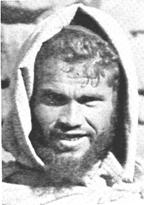|
(Photographic Supplement, Plate 44)
The Jews: I
The
Jews have been left to the end because they do not as a whole fit into any
single racial classification heretofore outlined. Historically the Jews of
the Biblical period in Palestine were a Semitic-speaking people composed of
various Mediterranean strains which had blended together at the time of the
formation of the Jewish nation. These Mediterranean strains must have
included a small Mediterranean type comparable to the present Yemeni Arabs;
a taller, longer-faced strain with a tendency to nasal convexity, as is
found among Irano-Afghan peoples today; and a straight-nosed, presumably
Atlanto-Mediterranean element contributed by the Philistines.
The Jews began their expansion from Palestine as early as the time of the
Babylonian Captivity; at this time they settled Mesopotamia in large
numbers, and from there began an expansion into central Asia of which
colonies still remain. In the Hellenistic period they migrated into Asia
Minor arid the Black Sea region, as well as into Egypt; these emigrants
became Hellenistic Jews. Under the Romans they settled in Italy, France, and
Spain, with especial concentrations in Spain and in the cities of the
Rhineland. The Jews expelled from Spain in 1492 and during previous
expulsions became the Sephardim, whose descendants are to be found in
various countries bordering on the Mediterranean, especially Morocco, the
Salonika region of what is now Greece, and Turkey. The Rhineland Jews,
persecuted at the time of the First Crusade, moved eastward into Poland, the
Ukraine, and other central European countries, and met there and absorbed a
group of Hellenistic Jews moving westward, among whom were some who had
lived among the Turkish Khazars in the Crimea and elsewhere. The two groups
blended, and the Germanic speech of the more numerous western element
prevailed. The modem Yiddish-speaking Ashkenazim are the descendants of this
amalgamated body. Racially they preserve to a large measure their
Mediterranean character, altered partly by Alpine admixture which has in
many cases produced Dinaricization. This Alpine, as well as some Nordic,
admixture was probably obtained largely in France and Germany before their
departure eastward. The most persistent Palestinian Mediterranean traits
which the Jews preserve is a narrowness of the face. The Jewish facial
expression, by which many Jews may be distinguished, is a cultural and not a
genetic character.
FIG. 1 (1 view, photo W. E. Forbes). A group of Yemenitic Jews
photographed in Sana'a, the Capital of Yemen. These Jews are derived from
more than one early Jewish source, but the bulk of their ancestors left
Palestine for Arabia very early. Their purely Mediterranean and essentially
Jewish facial and cranial character may be easily observed. They probably
come as close to the original Jewish prototype as do any living Jews.

FIG. 2 (1 view).
The Sheikh of the Jewish village of Zerekten, Glawa tribe, Atlas
Mountains, Morocco. These Berber-speaking mountain Jews have lived in
Morocco since not only pre-Islamic but probably also pre-Christian times;
nevertheless they are easily distinguishable from the Berbers with whom they
live. The sheikh here represented is aberrantly brachycephalic.

FIG. 3 (1 view).
A much more typical mountain Jew from the same colony.

FIG. 4 (1 view).
A group of Berber-speaking Jews. The man on the left has a concave nasal
profile; he belongs to a coarser Mediterranean type than does the man in
Fig. 3, or the tall Yemenitic Jew in Fig. 1.

|



